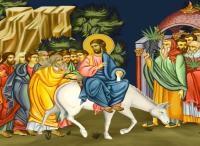
The feast of Passover is approaching. The Roman prefect Pontius Pilate enters Jerusalem in full regalia, either riding a war-horse or carried in a litter, accompanied by a procession of soldiers. He represents the occupying force of the mighty Roman Empire. It is essential that he is present in the city to maintain order. Jesus, on the other hand, enters through the north gate, riding on a colt. This is an animal that peasants might use; but it fulfils the prophecy of Zechariah 9:9:
Rejoice greatly, Daughter Zion.
Shout, Daughter Jerusalem!
Behold your King comes to you, righteous and victorious,
lowly and riding on a donkey,
on a colt, the foal of a donkey.
The contrast between the two processions is remarkable; yet the crowds cheer for Jesus and wave palm branches. The palm recalls the Festival of Booths, where people waved palm branches and other greenery which they then used to make temporary shelters, commemorating their sojourn in the desert.
Two very different parades represent the world of earthly power and the world of heavenly power. When teachers are being instructed in some places to teach unfettered capitalism as an ideal, it would be well to reflect on what St Ignatius calls "the two standards": that of Christ and that of the world.
Today we are being asked to reflect on the contrast between the ephemeral adulation of Palm Sunday and the lasting triumph of the cross. In Holy Week God turned wordly values upside down. The official of the Roman Empire, who sentenced Jesus to death, did not realise that the Empire he served would became a fertile ground for his Victim’s teachings to take root.